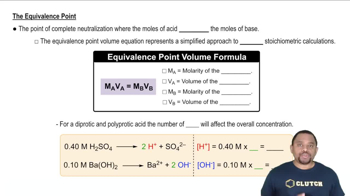The arsenic in a 1.22-g sample of a pesticide was converted to AsO43- by suitable chemical treatment. It was then titrated using Ag+ to form Ag3AsO4 as a precipitate. (a) What is the oxidation state of As in AsO43-?
Ch.4 - Reactions in Aqueous Solution
Chapter 4, Problem 113c
The arsenic in a 1.22-g sample of a pesticide was converted to AsO43- by suitable chemical treatment. It was then titrated using Ag+ to form Ag3AsO4 as a precipitate. (c) If it took 25.0 mL of 0.102 M Ag+ to reach the equivalence point in this titration, what is the mass percentage of arsenic in the pesticide?
 Verified step by step guidance
Verified step by step guidance1
Step 1: First, we need to determine the stoichiometry of the reaction. The balanced chemical equation is 3Ag+ + AsO4^3- -> Ag3AsO4. This tells us that 3 moles of Ag+ react with 1 mole of AsO4^3- to form 1 mole of Ag3AsO4.
Step 2: Next, we calculate the number of moles of Ag+ used in the titration. This can be done using the formula: moles = Molarity * Volume (in liters). In this case, the molarity of Ag+ is 0.102 M and the volume used is 25.0 mL or 0.025 L.
Step 3: Once we have the moles of Ag+, we can find the moles of AsO4^3- using the stoichiometry of the reaction. Since 3 moles of Ag+ react with 1 mole of AsO4^3-, the moles of AsO4^3- is one third of the moles of Ag+.
Step 4: Now, we can find the mass of arsenic in the sample. Since AsO4^3- contains one atom of arsenic, the moles of AsO4^3- is equal to the moles of arsenic. We can convert moles of arsenic to grams using the molar mass of arsenic (74.92 g/mol).
Step 5: Finally, we can calculate the mass percentage of arsenic in the pesticide. The mass percentage is calculated by dividing the mass of arsenic by the total mass of the sample and multiplying by 100.

Verified video answer for a similar problem:
This video solution was recommended by our tutors as helpful for the problem above.
Video duration:
6mWas this helpful?
Key Concepts
Here are the essential concepts you must grasp in order to answer the question correctly.
Titration and Equivalence Point
Titration is a quantitative analytical method used to determine the concentration of a solute in a solution. The equivalence point is reached when the amount of titrant added is stoichiometrically equivalent to the amount of substance being analyzed. In this case, the Ag+ ions react with AsO43- ions to form Ag3AsO4, allowing for the calculation of arsenic content based on the volume and concentration of Ag+ used.
Recommended video:
Guided course

Equivalence Point in Titration
Stoichiometry
Stoichiometry involves the calculation of reactants and products in chemical reactions based on balanced chemical equations. It allows chemists to determine the relationships between the quantities of substances consumed and produced. In this problem, stoichiometry is essential to relate the moles of Ag+ used in the titration to the moles of arsenic present in the pesticide sample.
Recommended video:
Guided course

Stoichiometry Concept
Mass Percentage
Mass percentage is a way of expressing the concentration of a component in a mixture as a percentage of the total mass. It is calculated by dividing the mass of the component by the total mass of the mixture and multiplying by 100. In this scenario, after determining the mass of arsenic from the titration data, the mass percentage can be calculated to understand how much arsenic is present in the pesticide sample relative to its total mass.
Recommended video:
Guided course

Mass Percent Calculation
Related Practice
Textbook Question
Textbook Question
The arsenic in a 1.22-g sample of a pesticide was converted to AsO43- by suitable chemical treatment. It was then titrated using Ag+ to form Ag3AsO4 as a precipitate. (b) Name Ag3AsO4 by analogy to the corresponding compound containing phosphorus in place of arsenic.
Textbook Question
Potassium superoxide, KO2, is often used in oxygen masks (such as those used by firefighters) because KO2 reacts with CO2 to release molecular oxygen. Experiments indicate that 2 mol of KO2(s) react with each mole of CO2(g). (b) Indicate the oxidation number for each atom involved in the reaction in part (a). What elements are being oxidized and reduced?
